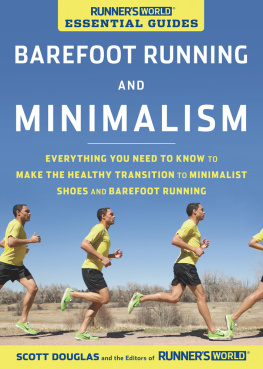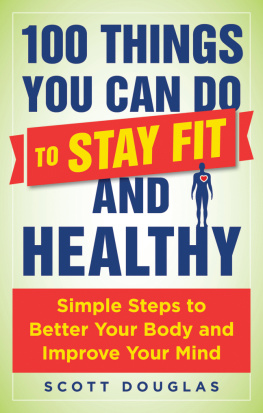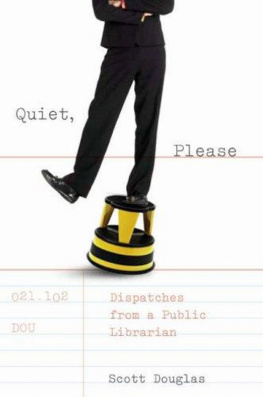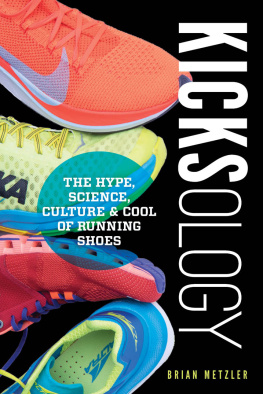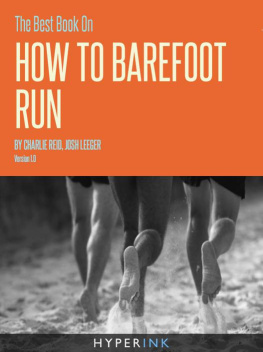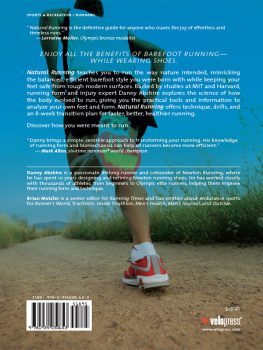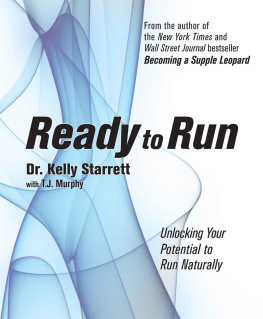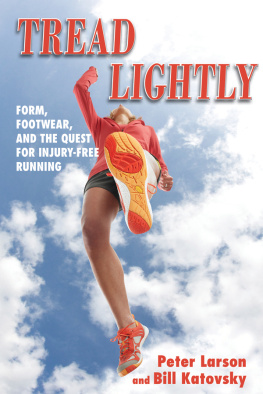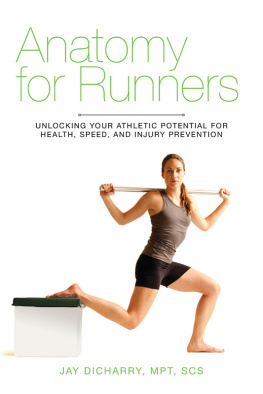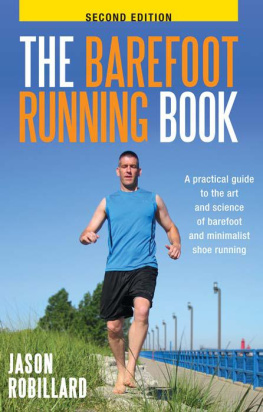INTRODUCTION
In the past few years, no aspect of running has been discussed more than what type of shoe and how much of it is best. Barefoot running has gone mainstream, and minimalism, or running in something other than conventional training shoes, has spread from a small segment of competitive runners to millions of regular runners. On a typical day on the Runners World message boards, you can read incredibly detailed and passionate debates about whether going barefoot is the route to running nirvana or the express lane to the doctors office. Youll hear vigorous defenses of modern running shoes, which have thick cushioning and a large drop from heel to toe, as well as some old-timers trying to provide a little perspective to what, to be frank, isnt a new topic.
This book isnt designed to end the debate about how much shoe is too much or too little. By now, the topic has sparked enough emotion that diehards on all sides have staked their ground and stopped listening to fellow runners who disagree. Instead, this book is for the vast majority of runners whove become intrigued by barefoot running and minimalism. These runners want to know a few simple things: Whats all the fuss about? Why do some people say less shoe is better? How do I know if its for me? And if I decide to try to run in less shoe, how do I go about doing so safely, so that I can reap the rewards while avoiding potential risks?
To help you answer those questions, this book is divided into three main parts. First, to help you put the issues in perspective, we provide some background on barefoot running and minimalism. The goal here is to remind runners that topics that seemed to come out of nowhere the past couple of years have actually been investigated by other runners decades ago in the ultimate lab of human performance. Second, the rationale for barefoot running and minimalism. Why do proponents say its worth ditching your conventional running shoes? Third, the technique. How can you tell if your body is ready to run in less shoe, and how can you intelligently progress toward doing so?
After those three main parts, we provide some concluding thoughts on the barefoot/minimalist movement and, for the running parents out there, a look at what type of shoes the next generation of runners should be in during their crucial formative years.
We hope you find this book, based on the expertise of Runners World and Running Times editors and contributors, a rational, reasoned resource in your quest for a lifetime of enjoyable running.
A NOTE FROM THE EDITOR
DAVID WILLEY, EDITOR-IN-CHIEF, RUNNERS WORLD
When I started working at Runners World in 2003, I began learning about the intricacies and differing theories of running form, and trying to improve mine. Is it possible that I shouldve just taken off my shoes? Christopher McDougall thinks so. Thanks in large part to his bestselling book, Born to Run (2009), barefoot runningwhich fosters a forefoot strikeis again in vogue. In response to barefoot fever and the success of the Vibram FiveFingers barefoot shoes, manufacturers from Nike to New Balance have developed minimalist models with very little cushioning, lower heel heights, and no motion-control features.
While I understand the appeal of this simple, back-to-basics trend, theres also a lot of hype and confusion. The vast majority of us simply dont have the strength or flexibility in our lower legs to become forefoot-strikers overnight. We need time to adjust without getting hurt.
Dont get me wrongIm not anti-minimalism, or even anti-barefoot. A few days a week, I wear minimalist shoes around the office. My feet get tired, but thats the point. Theyre getting stronger. Ive also run a few 5-Ks and half-marathons in Saucony Kinvaras, and some easy trail runs in New Balance 101s. And yes, I have a pair of FiveFingers Bikilas, the current stars of the minimalist show. Once I got them on for the first time (getting each toe in its proper home is more like squeezing into a wetsuit than donning a pair of slippers), I couldnt help but smile. They feel good. Theyre fun. Every week or two, I run some strides on grass and can feel my forefoot padding the ground. They serve a purpose. Still, these arent my running shoes, any more than my road bike is a full-time substitute for my car. I have a history of Achilles tendinitis, so Im trying to balance the virtues of forefoot running against the risks of putting too much stress on my lower legs too soon. And thats my beef with the evangelists who think all of us should swear off shoes and start running barefoot tomorrow. Theres no single answer or prescription thats right for every runner when it comes to footwear and running form.
More people have asked me about this topic lately than about any other I can recall over the past eight years. What are they like? they ask breathlessly when I wear my FiveFingers to the coffee shop. Should I be running barefoot? I tell them that going back to basics can be complicated, and that its best to try to see the long view. Theres no scientific evidence that running shoes prevent (or cause) injuriesjust as theres no proof that barefoot running does. And minimalist shoes? Its too soon to tell. But as the pendulum continues to swing, Ill keep running in different shoes for different reasons (and occasionally go barefoot), all with an open mind.
THE HISTORY OF BAREFOOT RUNNING AND MINIMALISM
For decades, modern runners have been going barefoot and doing much of their mileage in minimal shoes. In this section, youll learn from two veteran experts how previous runners experiences and experiments can help you decide what approach might be best for you.
A BRIEF HISTORY OF BAREFOOT RUNNING, PART 1
Barefoot running has its virtues, and running shoes have their virtues. Can they peacefully coexist?
BY AMBY BURFOOT, EDITOR AT LARGE, RUNNERS WORLD
As a teenager, I loved to run barefoot on the Connecticut beaches, splashing through the waves. A few years later, I often ran without shoes while training for the college cross-country season, completing workouts that were the hardest, fastest, most puke-able, and yet most enjoyable of my life.
Those are strange bedfellows: extreme effort and high pleasure. I have wondered if someone was spiking my Kool-Aid, a popular sports drink of the time. Then I close my eyes and recall how my friends and I snuck onto Shennecossett Golf Course as dusk descended. How we giddily removed our shoes and felt the fairway underfoot. How we ran an undulating six-mile fartlek loop, sprinting and jogging, sprinting and jogging, the summer sweat cascading off our bodies. How we finished, not another gasp of oxygen in our lungs, and flopped onto the 14th green. The kinesthetic memories are full-blown, from the slight chill of the grass on my feet to the heaving chest and the lightheaded dizziness of the effort. Was it the barefoot running that made the memory so vivid?
Of course, famous runners had gone barefoot, paving the way before us. In 1960 Ethiopias Abebe Bikila, the greatest Olympic marathoner of all time, won the first of his consecutive gold medals sans shoes in a world record 2:15:17. High school running coach, Young John J. Kelley, was the leading American finisher (19th, 2:24:58) in that 1960 Rome Olympic Marathon, and his descriptions of the torchlit race are bewitching. Except the part about the stones.

